A Protocol for Evaluating Contextual Design Principles
Abstract
:1. Introduction
1.1. The Cochrane Method
1.1.1. An Experimental Protocol
1.1.2. Validation of the Proposed Protocol
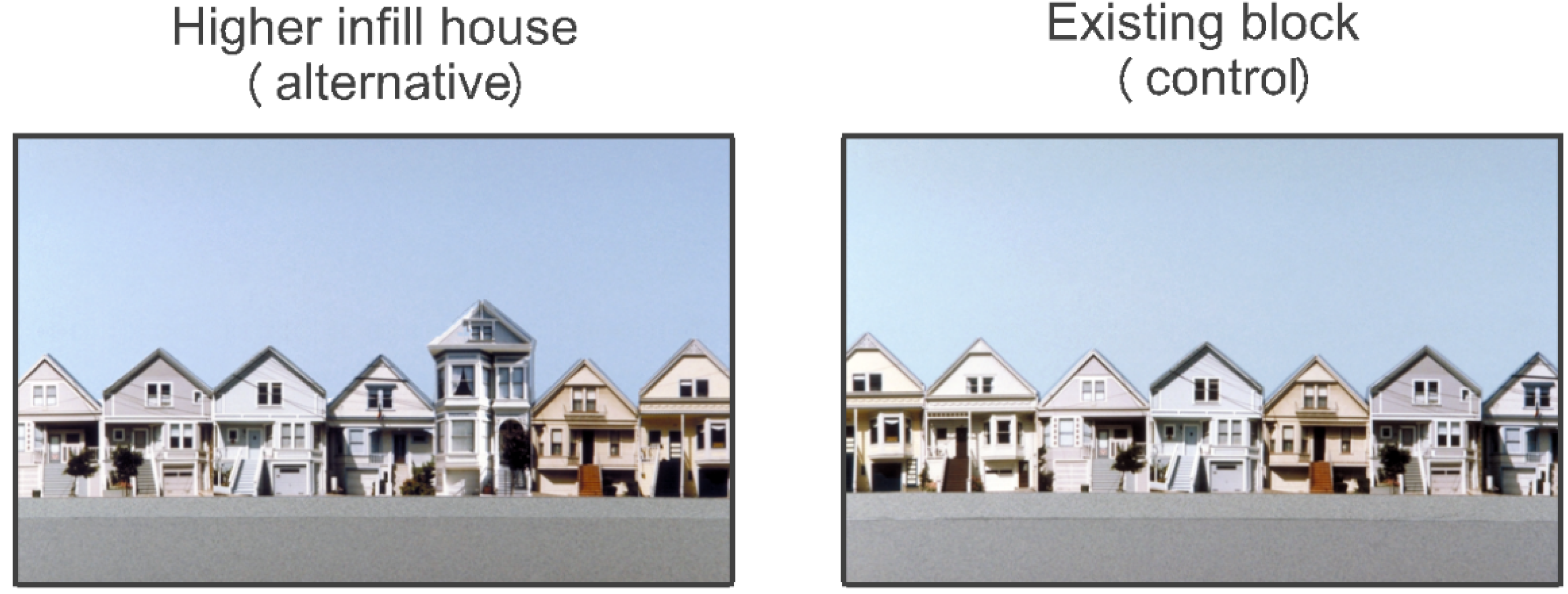
1.2. Part 2 of a Cochrane Method
1.2.1. Meta-Analysis
“How do you know if one treatment will work better than another, or if it will do more harm than good? Cochrane Reviews are systematic reviews of primary research in human health care and health policy, and are internationally recognized as the highest standard in evidence-based health care. They investigate the effects of interventions for prevention, treatment and rehabilitation. They also assess the accuracy of a diagnostic test for a given condition in a specific patient group and setting. They are published online in The Cochrane Library”.[30]
1.2.2. Converting Meta-Analytic Findings into Implementation Recommendations
| Individual | Collective Results | ||||||
|---|---|---|---|---|---|---|---|
| Alternative | Experiment | nstim | r | Σ nstim |  | p-level | 0.05 CI |
| Plan A | Exp. 1 | 20 | 0.85 | ||||
| Plan A | Exp. 2 | 50 | 0.70 | ||||
| Plan A | Exp. 3 | 75 | 0.77 | ||||
| Synthesis | Exp. 1, 2 and 3 | 145 | 0.76 | 5e−28 | 0.68, 0.82 | ||
| Plan B | Exp. 4 | 25 | 0.10 | ||||
| Plan B | Exp. 5 | 50 | 0.15 | ||||
| Plan B | Exp. 6 | 70 | 0.12 | ||||
| Synthesis | Exp. 4, 5 and 6 | 145 | 0.13 | 0.075 | −0.03, 0.28 | ||
2. Applications
2.1. Little Boxes
2.1.1. The Venue
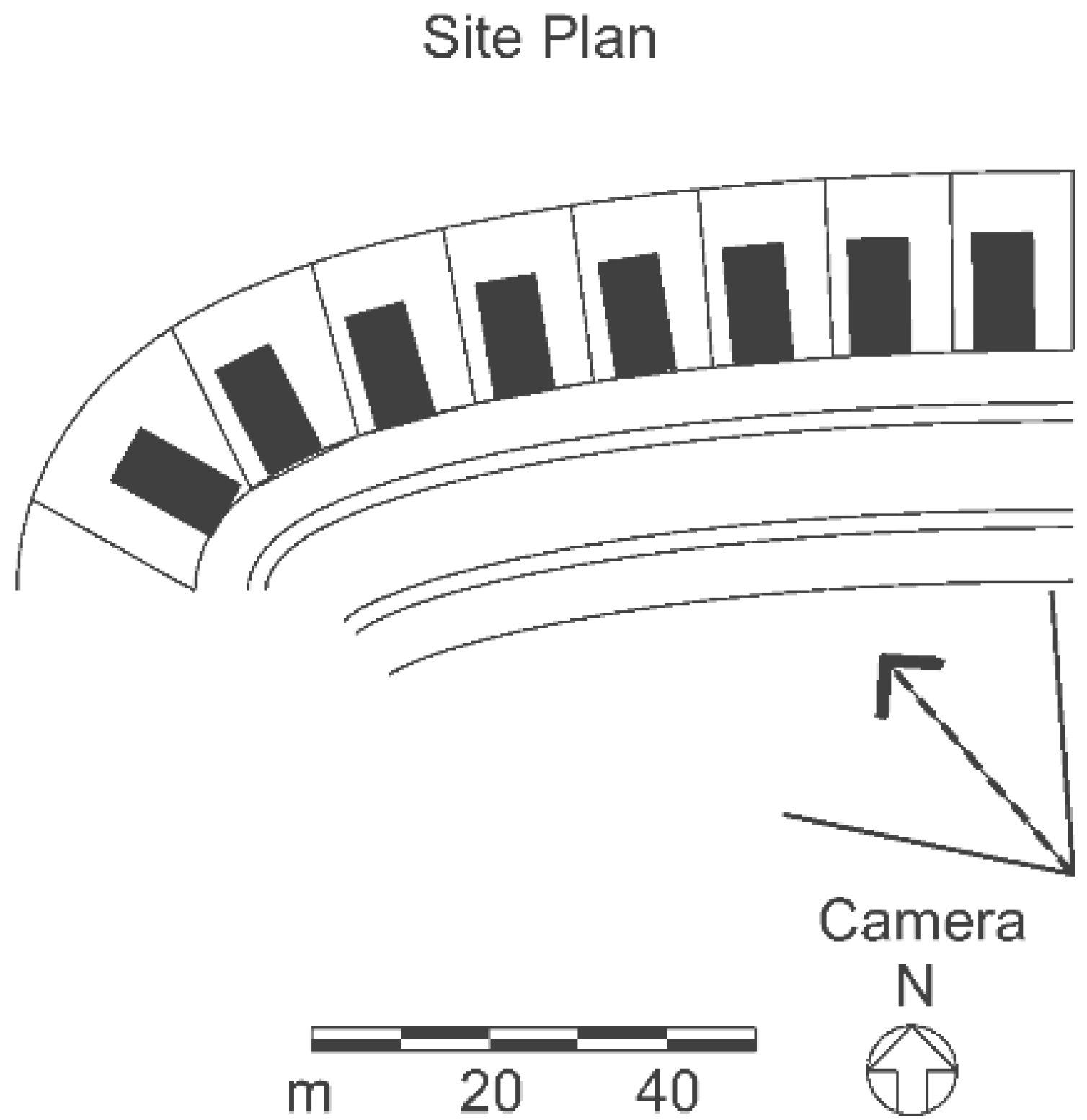
2.1.2. Experimental Design and Stimuli
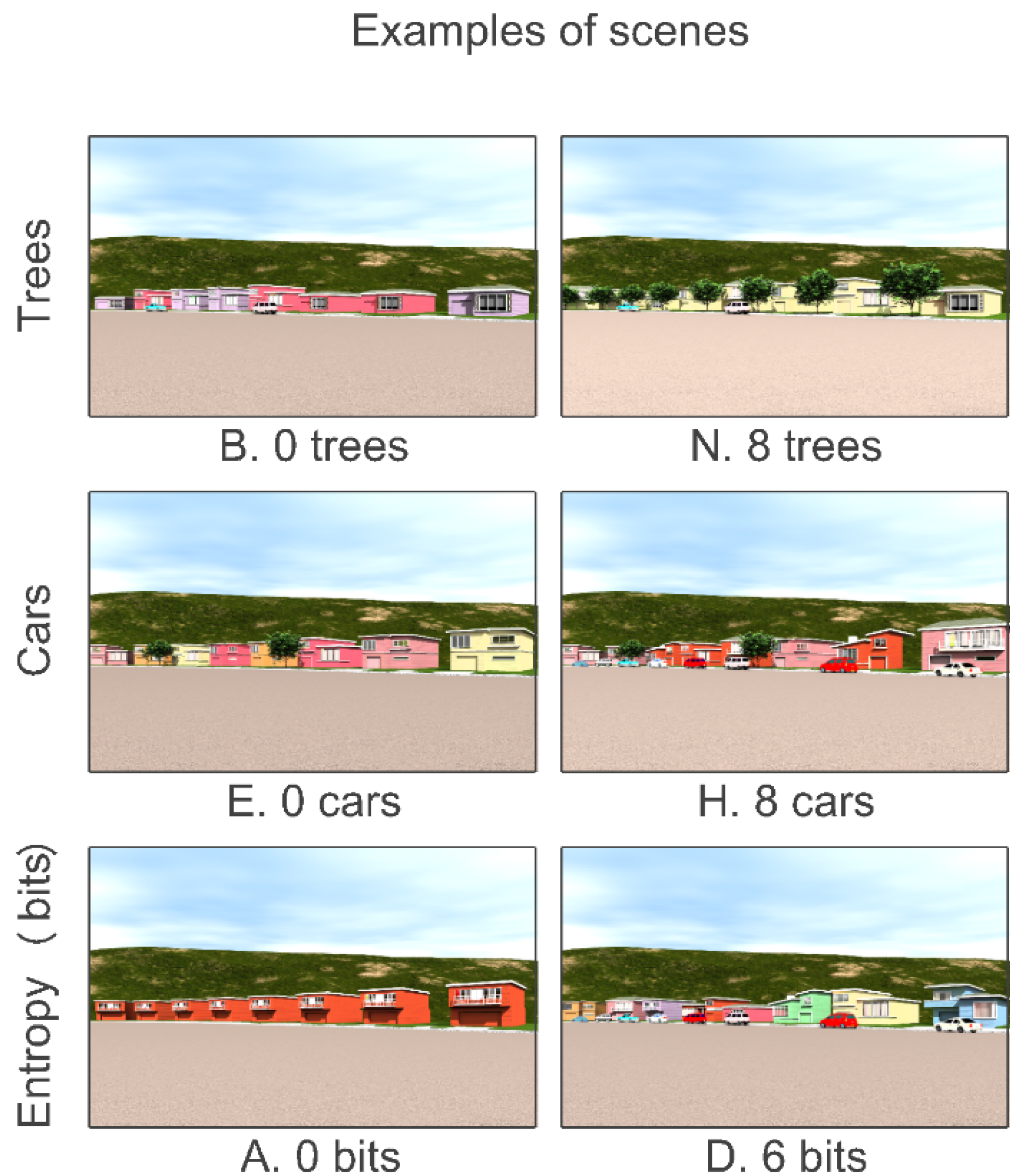
2.1.3. Data Acquisition
2.1.4. Results
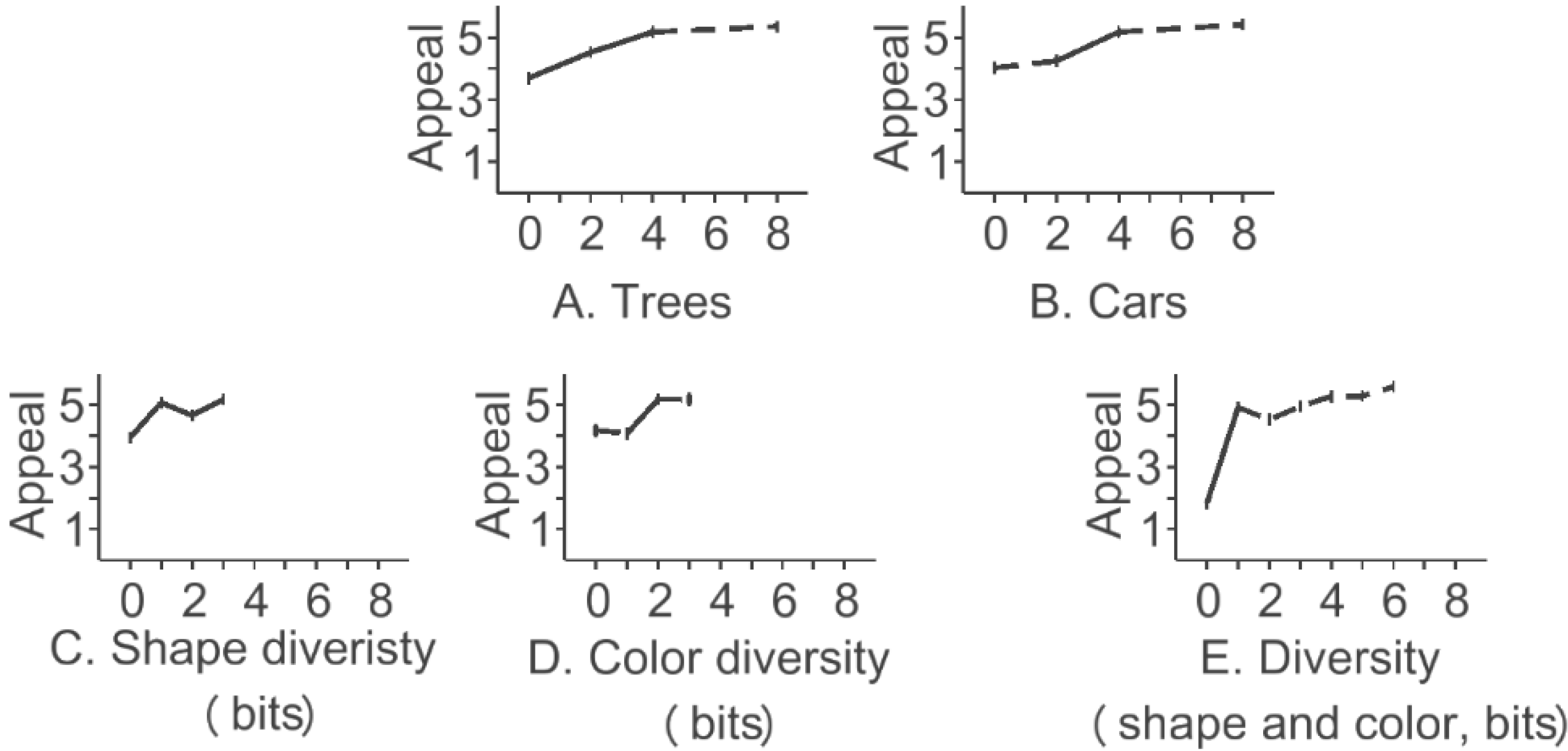
2.2. Car vs. No Car
2.2.1. The Venue
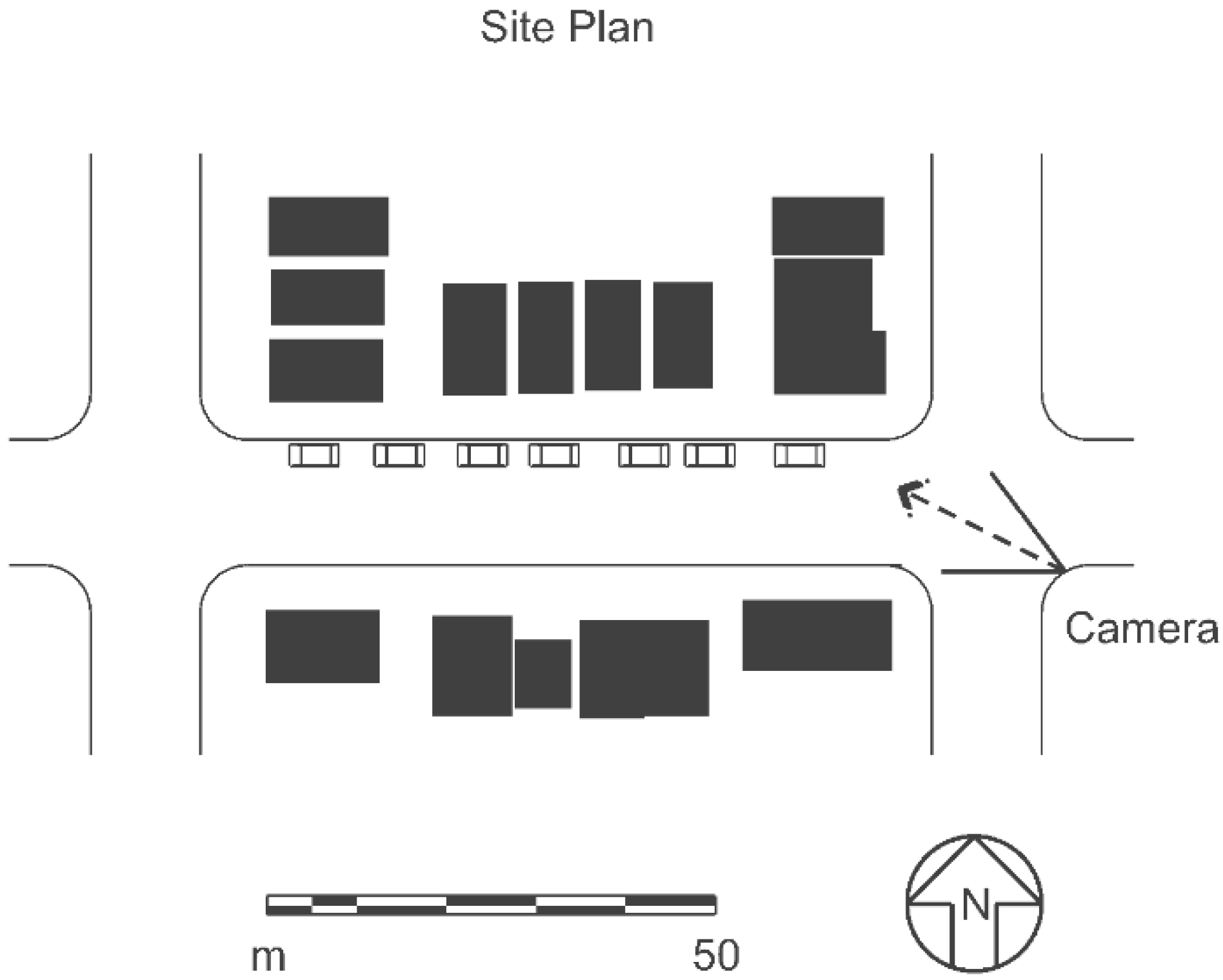
2.2.2. Experimental Design and Stimuli
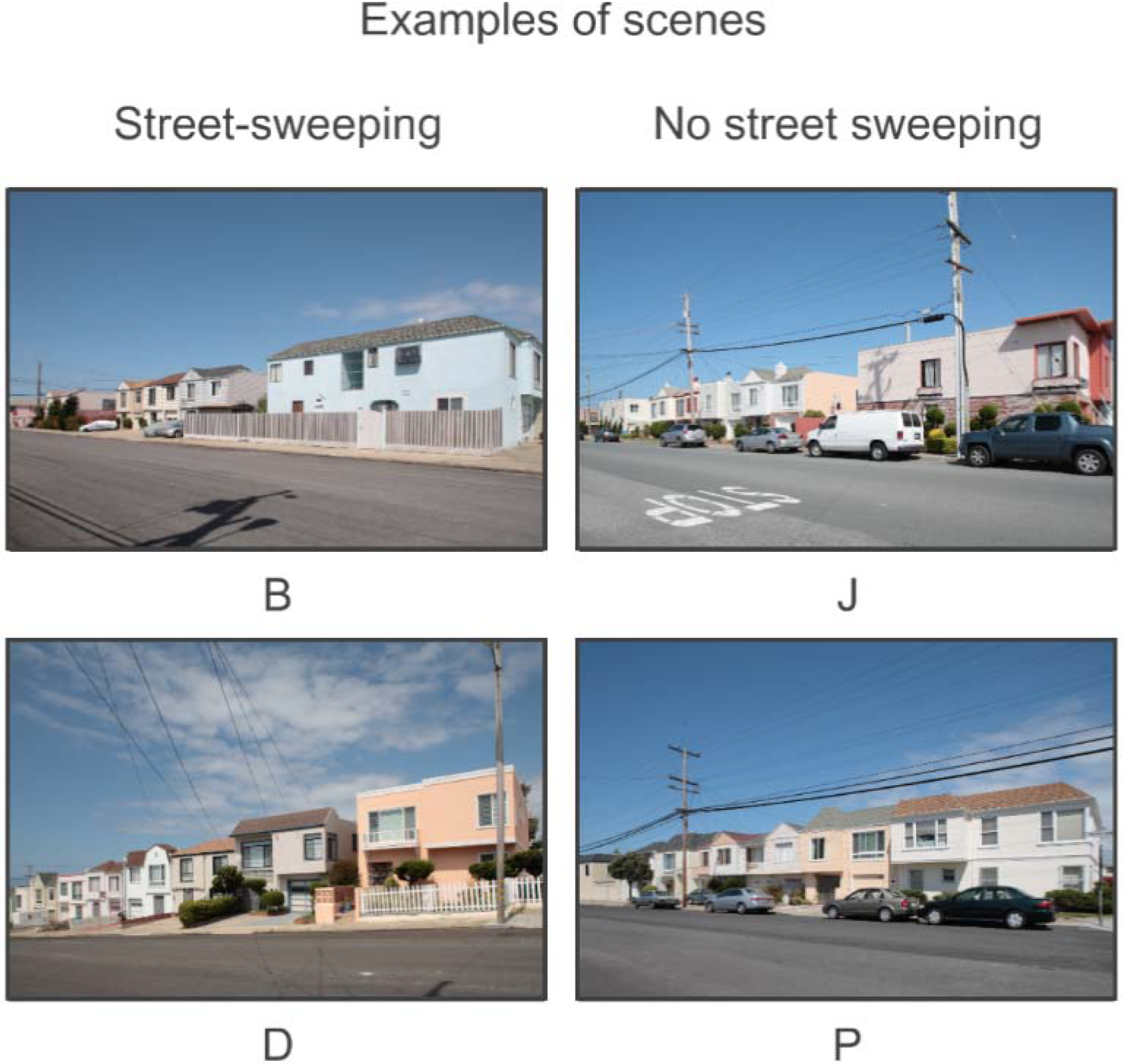
2.2.3. Data Acquisition
2.2.4. Results
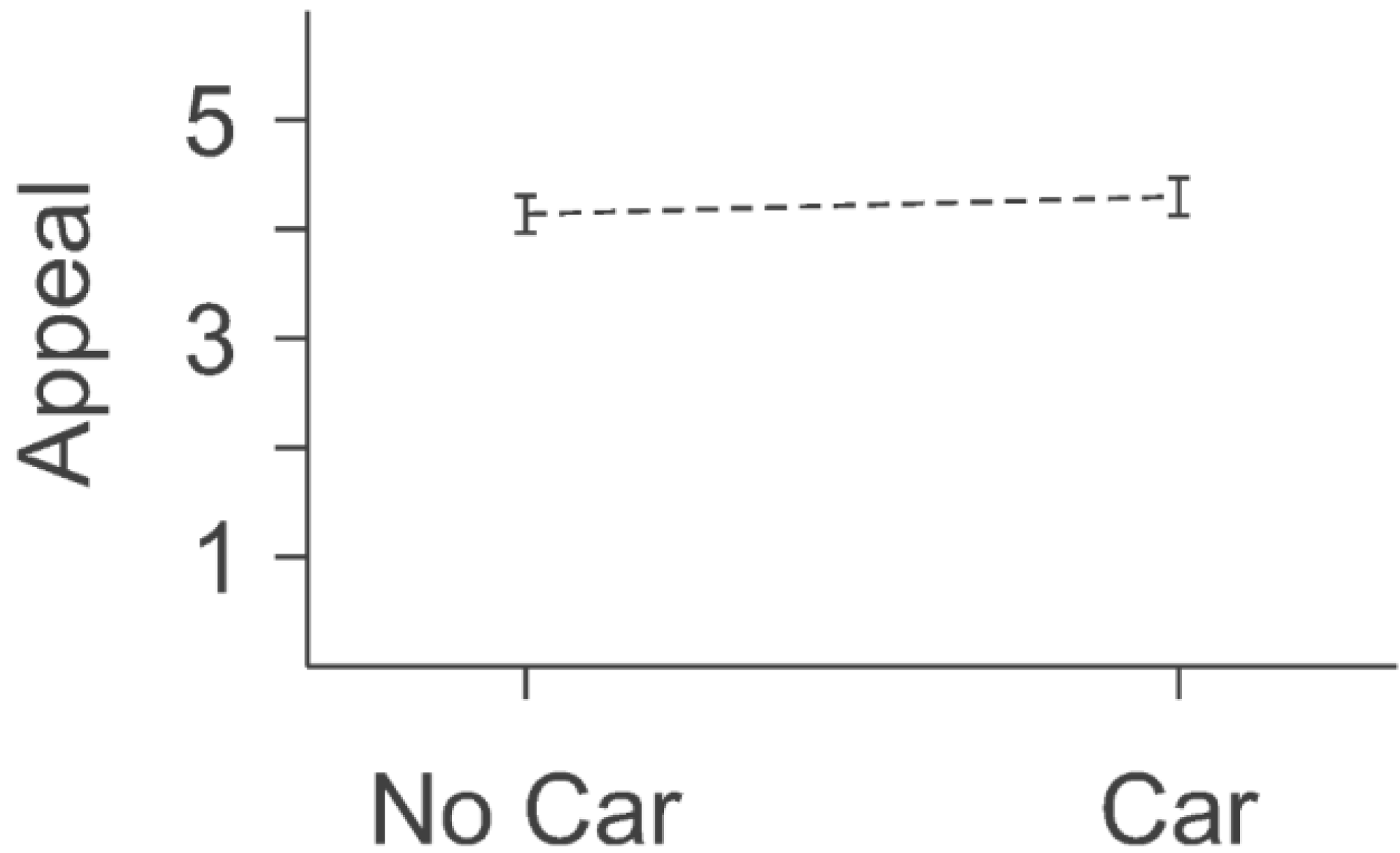
2.3. “New” Amsterdam
2.3.1. The Venue
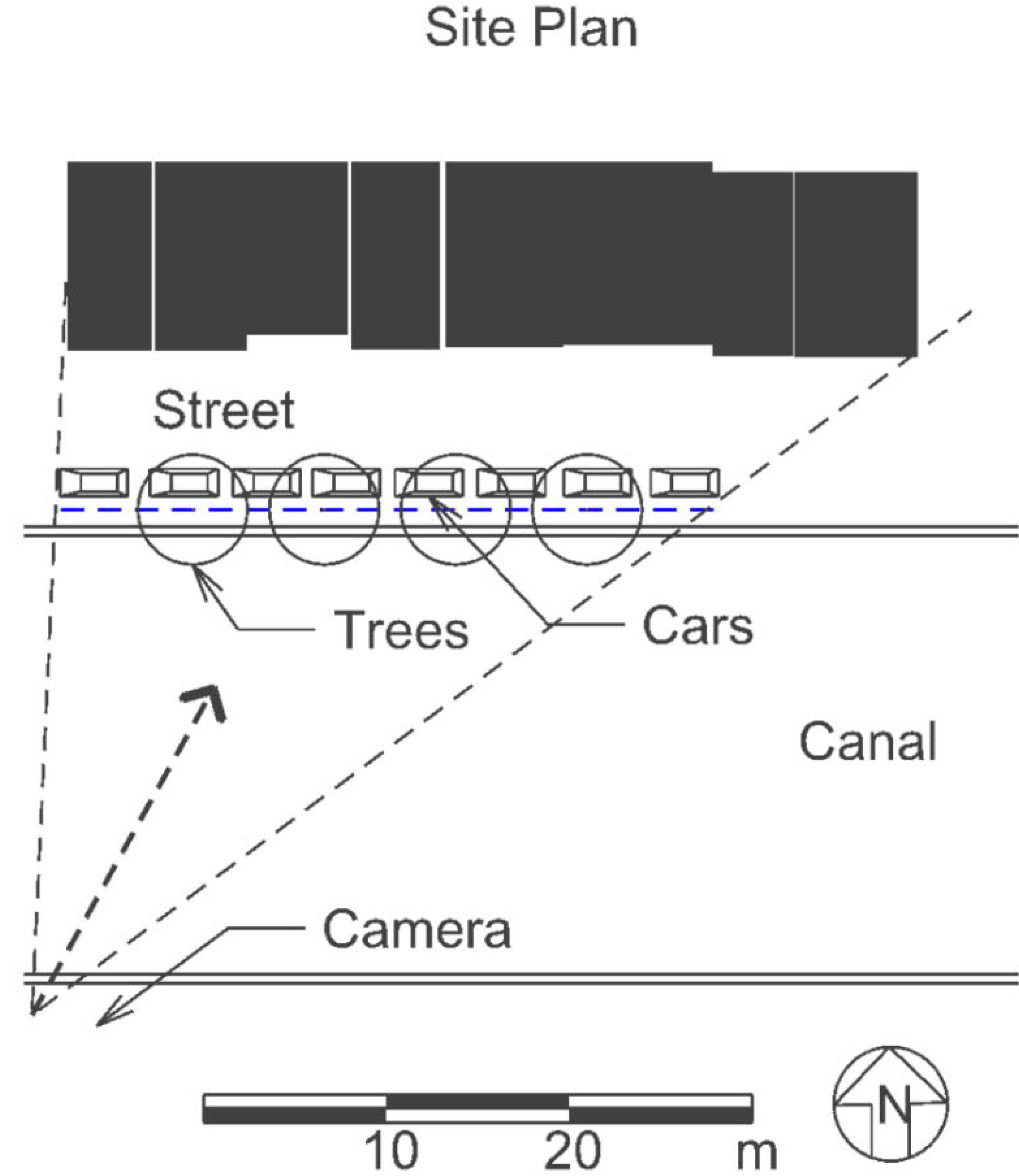
2.3.2. Experimental Design and Stimuli
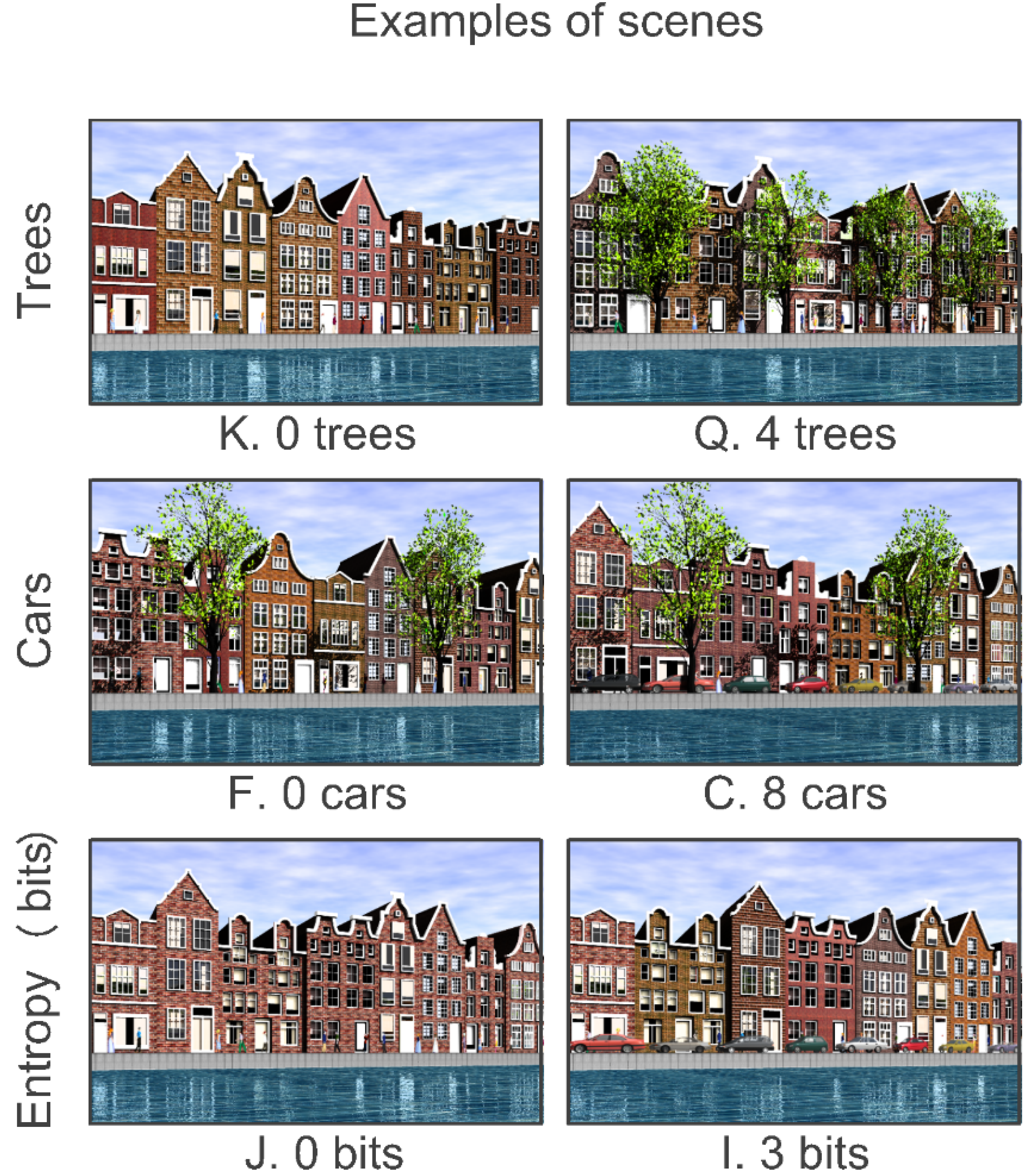
2.3.3. Data Acquisition
2.3.4. Results

3. Synthesis
 ”, and “0.05 CI”. The data listed in Table 1 are useful for detailed applications and research; however, the sheer quantity of information can be over-whelming, and valid generalizations can be obscured by all of that detail. Fortunately, this is precisely the problem that can be solved with meta-analysis. Application of meta-analysis to the data in Table 1 produces the list of the efficacies of seven contextual design principles listed in Table 2.
”, and “0.05 CI”. The data listed in Table 1 are useful for detailed applications and research; however, the sheer quantity of information can be over-whelming, and valid generalizations can be obscured by all of that detail. Fortunately, this is precisely the problem that can be solved with meta-analysis. Application of meta-analysis to the data in Table 1 produces the list of the efficacies of seven contextual design principles listed in Table 2.| Design Feature | Experiments | Σ nstim |  | p-level | 0.05 CI |
|---|---|---|---|---|---|
| Infill Style | 29–38 | 191 | 0.64 | 7e−23 | 0.54, 0.71 |
| Trees | 46–55 | 252 | 0.62 | 1e−27 | 0.53, 0.69 |
| Diversity | 10–12, 15, 21–24, 27, 28 | 136 | 0.51 | 5e−10 | 0.37, 0.62 |
| Infill Height | 39–42 | 106 | −0.38 | −0.53, −0.20 | |
| Distance * | 6–9 | 97 | 0.12 | 0.12 | −0.08, 0.31 |
| Third Story Setback | 43–45 | 56 | −0.10 | 0.23 | −0.35, 0.16 |
| Cars | 1–5 | 106 | −0.07 | 0.71 | −0.25, 0.12 |
4. Discussion
4.1. Scope
4.2. Technical Details
4.3. Advisory or Mandatory
5. Conclusions
Appendix
| # | Design Feature | Venue | Units | Range | nsubjt | nstimt | r | Source |
|---|---|---|---|---|---|---|---|---|
| 1 | Cars | Urban streets | Area of cars in image | 0%–12% | 43 | 32 | −0.40 | Stamps and Miller [72] |
| 2 | Cars | Urban streets | Cars | Present-absent | 42 | 24 | −0.03 | Stamps [73] |
| 3 | Cars | Suburban streets | Cars | 0–8 | 29 | 16 | 0.46 | Little Boxes |
| 4 | Cars | Urban streets | Cars | 0–7 | 24 | 16 | 0.13 | Car vs. No Car |
| 5 | Cars | European streets | Cars | 0–8 | 24 | 18 | −0.11 | “New” Amsterdam |
| 6 | Distance | Urban streets | Meters | 15–37 | 37 | 24 | 0.19 | Stamps [24] |
| 7 | Distance | Urban streets | Meters | 7.5–120 | 18 | 24 | 0.16 | Stamps [24] |
| 8 | Distance | Urban streets | Meters | 22.6–34.7 | 24 * | 24 | 0.01 | Stamps [24] |
| 9 | Distance | Suburban streets | Meters | 31.5–245 | 90 | 25 | 0.11 | Nasar and Stamps [74] |
| 10 | Diversity | Residential blocks | H (Colors) | 0.0–2.8 | 57 | 6 | 0.97 | Stamps [38] |
| 11 | Diversity | Residential blocks | H (size) | 0.0–2.8 | 57 * | 6 | 0.94 | Stamps [38] |
| 12 | Diversity | Residential blocks | H (silhouette) | 0.0–2.8 | 57 * | 6 | 0.96 | Stamps [38] |
| 13 | Diversity | Residential blocks | H (silhouette) | 0.0–2.8 | 57 * | 16 | (0.28) | Stamps [38] |
| 14 | Diversity | Residential blocks | H (articulation) | 0.0–2.8 | 57 * | 16 * | (0.36) | Stamps [38] |
| 15 | Diversity | Residential blocks | H (silhouette and articulation) | 0.0–5.6 | 57 * | 16 * | 0.57 | Stamps [38] |
| 16 | Diversity | Barns | H (Shapes) | 0.0–3.0 | 63 | 17 | (0.63) | Stamps [39] |
| 17 | Diversity | Barns | H (Materials) | 0.0–3.0 | 63 * | 17 * | (0.73) | Stamps [39] |
| 18 | Diversity | Barns | H (Articulation) | 0.0–2.0 | 63 * | 17 * | (0.62) | Stamps [39] |
| 19 | Diversity | Barns | H (Openings) | 0.0–2.0 | 63 * | 17 * | (0.50) | Stamps [39] |
| 20 | Diversity | Barns | H (Opening color) | 0.0–2.0 | 63 * | 17 * | (0.51) | Stamps [39] |
| 21 | Diversity | Barns | H (overall) | 0.0–12.0 | 63 * | 17 | 0.84 | Stamps [39] |
| 22 | Diversity | Residential block faces | H (styles) | 0.0–2.0 | 20 | 15 | 0.31 | Stamps [8] |
| 23 | Diversity | Residential block faces | H (styles) | 0.94–2.15 | 89 | 18 | −0.04 | Stamps [8] |
| 24 | Diversity | Residential block faces | H (styles) | 0.94–2.55 | 39 | 18 | 0.06 | Stamps [8] |
| 25 | Diversity | Suburban street | H (shape) | 0.0–3.0 | 29 | 16 * | (0.29) | Little Boxes |
| 26 | Diversity | Suburban street | H (color) | 0.0–3.0 | 29 * | 16 * | (0.46) | Little Boxes |
| 27 | Diversity | Suburban streets | H (shape and color) | 0.0–6.0 | 29 * | 16 * | 0.68 | Little Boxes |
| 28 | Diversity | European street | H (bricks) | 0.0–3.0 | 24 * | 18 | 0.07 | “New” Amsterdam |
| 29 | Infill style | Urban streets | Styles | Victorians vs. Stucco Box | 45 | 20 | 0.96 | Stamps [75] |
| 30 | Infill style | Urban Streets | Styles | Match scale and character | 45 * | 8 | 0.57 | Stamps [20] |
| 31 | Infill style | Residential block faces | Styles | Sea Side: Raspberry surprise | 90 * | 25 * | 0.96 | Nasar and Stamps [74] |
| 32 | Infill style | Residential block faces | Styles | Ranch: Sea Ranch | 38 | 18 | 0.30 | Nasar and Stamps [74] |
| 33 | Infill style | Residential block faces | Styles | Sea Ranch: Ranch | 50 | 18 | 0.15 | Nasar and Stamps [74] |
| 34 | Infill style | Residential block faces | Styles | Sea Ranch: Ranch | 26 | 18 | 0.70 | Nasar and Stamps [74] |
| 35 | Infill style | Residential block faces | Styles | Sea Ranch: Ranch | 22 | 18 | 0.47 | Nasar and Stamps [74] |
| 36 | Infill style | Residential block faces | Styles | Sea Ranch: I Beam | 25 | 27 | −0.02 | Nasar and Stamps [74] |
| 37 | Infill style | Residential block faces | Styles | Moss Beach to Sea Ranch | 26 | 15 | 0.65 | Stamps [8] |
| 38 | Infill style | Urban streets | Styles | Avant-garde, I Beam | 18 * | 24 * | 0.26 | Stamps [24] |
| 39 | Infill height | Urban streets | % of existing height | 100–200% | 45 | 40 | −0.20 | Stamps [14](pp. 226–235) |
| 40 | Infill height | Residential block faces | % of existing height | 133–400% | 22 * | 18 | −0.67 | Nasar and Stamps [74] |
| 41 | Infill height | Urban streets | % of existing height | 100–150% | 37 * | 24 * | 0.39 | Stamps [24] |
| 42 | Infill height | Urban streets | % of existing height | 100–200% | 18 * | 24 * | −0.85 | Stamps [24] |
| 43 | Setback | Urban streets | Top floor setback | Yes/No | 24 * | 24 * | 0.01 | Stamps [24] |
| 44 | Setback | Urban streets | Top floor setback | Yes/No | 29 * | 16 * | −0.14 | Stamps [24] |
| 45 | Trees | Urban streets | Trees | 0–2 | 29 * | 16 | −0.25 | Stamps [24] |
| 46 | Trees | Urban streets | Area of trees in image | 0–17% | 43 * | 32 * | 0.32 | Stamps and Miller [72] |
| 47 | Trees | German streets | Trees | Present-absent | 103 | 18 | 0.39 | Weber, Schnier, and Jacobsen [76] |
| 48 | Trees | Michigan streets | Trees | Number and size | 149 | 42 | 0.80 | Schroeder, Buhyoff, and Cannon [77] |
| 49 | Trees | Ohio Streets | Trees | Number and size | N/A | 60 | 0.67 | Schroeder, Buhyoff, and Cannon [77] |
| 50 | Trees | Urban streets | Trees | Present or absent | 42 * | 24 * | 0.57 | Stamps [73] |
| 51 | Suburban streets | Trees | Tree diameter | 61 | 20 | 0.57 | Lien and Buhyoff [78] | |
| 52 | Streets, industrial areas, buildings | Natural elements | Present-absent | 214 | 6 | 0.71 | Hernandez and Hidalgo [79] | |
| 53 | Urban streets | Trees | 0–2 | 29 * | 16 * | −0.25 | Stamps [24] | |
| 54 | Urban streets | Trees | 0–8 | 29 * | 16 * | 0.50 | Little Boxes | |
| 55 | Urban streets | Trees | 0–4 | 24 * | 18 * | 0.92 | “New” Amsterdam |
Conflicts of Interest
References
- Calderon, E. Design control in the Spanish planning system. Built Environ. 1994, 20, 157–168. [Google Scholar]
- Lightner, B.C. Survey of Design Review Practices; American Planning Association: Chicago, IL, USA, 1993. [Google Scholar]
- Loew, S. Design control in France. Built Environ. 1994, 20, 88–103. [Google Scholar]
- Nelissen, N.; de Vocht, C.L. Design control in the Netherlands. Built Environ. 1994, 20, 142–156. [Google Scholar]
- Nystrom, L. Design control in planning: The Swedish case. Built Environ. 1994, 20, 113–126. [Google Scholar]
- Pantel, G. Design control in German Planning. Built Environ. 1994, 20, 104–112. [Google Scholar]
- Vignozzi, A. Design control in Italian planning. Built Environ. 1994, 20, 127–141. [Google Scholar]
- Stamps, A.E. Parameters of contextual fit: Diversity, matching, individual style, responses. J. Urban. 2011, 4, 7–24. [Google Scholar]
- Smit, A.J. The influence of district visual quality on location decisions of creative entrepreneurs. J. Am. Plan. Assoc. 2011, 77, 167–184. [Google Scholar] [CrossRef]
- Talen, E. Measuring urbanism: Issues in smart growth research. J. Urban. Des. 2003, 8, 195–315. [Google Scholar] [CrossRef]
- Cao, X.; Mokhtarian, P.L.; Handy, S.L. No particular place to go: An empirical analysis of travel for the sake of travel. Environ. Behav. 2009, 41, 233–257. [Google Scholar]
- Gans, H. Popular Culture and High Culture; Basic Books: New York, NY, USA, 1974. [Google Scholar]
- Rand, A. The Fountainhead; Signet: Chicago, IL, USA, 1943. [Google Scholar]
- Stamps, A.E. Psychology and the Aesthetics of the Built Environment; Kluwer Academic: Norwell, MA, USA, 2000. [Google Scholar]
- Cochrane, A.L. Effectiveness and Efficiency: Random Reflections on Health Services, 2004 Ed. ed; Royal Society of Medicine Press: London, UK, 1972. [Google Scholar]
- Glass, G.V. Primary, secondary, and meta-analysis of research. Educ. Res. 1976, 5, 3–8. [Google Scholar] [CrossRef]
- Rosenthal, R.; Rosnow, R.L. Contrast Analysis: Focused Comparisons in the Analysis of Variance; Cambridge University Press: Cambridge, UK, 1985. [Google Scholar]
- Winer, B.J.; Brown, D.R.; Michels, K.M. Statistical Principles in Experimental Design; Mc Graw-Hill: New York, NY, USA, 1991. [Google Scholar]
- Tabachnick, B.G.; Fidell, L.S. Computer-Assisted Research Design and Analysis; Allyn and Bacon: Boston, MA, USA, 2001. [Google Scholar]
- Stamps, A.E. A study in scale and character: Contextual effects on environmental preferences. J. Environ. Manag. 1994, 42, 223–245. [Google Scholar] [CrossRef]
- Rosenthal, R.; Rosnow, R.L. Essentials of Behavioral Research: Methods and Data Analysis; McGraw-Hill: New York, NY, USA, 1991. [Google Scholar]
- Silvergold, B. Richard Morris Hunt and the Importation of Beaux-Arts Architecture to the United States. Ph.D. Dissertation, University of California, Berkeley, CA, USA, 1974. [Google Scholar]
- Stamps, A.E. Use of static and dynamic media to simulate environments: A meta-analysis. Percept. Motor Skills 2010, 111, 1–12. [Google Scholar]
- Stamps, A.E. Efficient visualization of urban spaces. In Usage, Usability, and Utility of 3D City Models; Leduc, T., Moreau, G., Billen, R., Eds.; Edp Sciences: Les Ulis, France, 2012. [Google Scholar]
- Stamps, A.E. How distance mitigates perceived threat at 30–90 m. Percept. Motor Skills 2012, 114, 1–8. [Google Scholar] [CrossRef]
- Borenstein, M.; Hedges, L.V.; Higgins, J.P.; Rothstein, H.R. Introduction to Meta-Analysis; Wiley: New York, NY, USA, 2009. [Google Scholar]
- Cook, T.D.; Cooper, H.; Cordray, D.S.; Hartman, H.; Hedges, L.V.; Light, R.J.; Louis, T.A.; Mosteller, F. Meta-Analysis for Explanation; Russell Sage: New York, NY, USA, 1994. [Google Scholar]
- Hartung, J.; Knapp, G.; Sinha, B.K. Statistical Meta-Anaysis with Applications; Wiley: New York, NY, USA, 2008. [Google Scholar]
- Hedges, L.V.; Olkin, I. Statistical Methods for Meta-Analysis; Academic Press: Orlando, FL, USA, 1985. [Google Scholar]
- Cochrane Collaboration Cochrane Reviews. Available online: www.cochrane.org/cochrane-reviews (accessed on 13 July 2013).
- Dickersin, K. To reform U.S. health care, start with systematic reviews. Science 2010, 329, 516–517. [Google Scholar] [CrossRef] [PubMed]
- Cochrane Collaboration About-us. Available online: www.cochrane.org/about-us (accessed on 13 July 2013).
- Cochrane Collaboration Cochrane handbook for systematic reviews of interventions. Available online: http://www.cochrane.org (accessed on 21 August 2013).
- Reynolds, M. Little Boxes and Other Handmade Songs; Oak Publications: New York, NY, USA, 1964. [Google Scholar]
- Keil, R. Little Boxes: The Architecture of a Classic Midcentury Suburb; Advection Media: Daly City, CA, USA, 2006. [Google Scholar]
- Watch, M.; Hope, A. Living Colors The Definitive Guide to Color Palettes through the Ages; Chronicle Books: San Francisco, CA, USA, 1995. [Google Scholar]
- Cochran, W.G.; Cox, G.M. Experimental Designs; Wiley: New York, NY, USA, 1957. [Google Scholar]
- Stamps, A.E. Entropy, visual diversity and preference. J. Gen. Psychol. 2002, 129, 300–320. [Google Scholar] [CrossRef] [PubMed]
- Stamps, A.E. Advances in visual diversity and entropy. Environ. Plan. B 2003, 30, 449–463. [Google Scholar] [CrossRef]
- Stamps, A.E. Entropy and visual diversity in the environment. J. Archit. Plan. Res. 2004, 21, 239–256. [Google Scholar]
- Ungaretti, L. San Franciscoʼs Sunset District; Arcadia: Charlestown, SC, USA, 2003. [Google Scholar]
- Cohen, J. Statistical Power Analysis for the Behavioral Sciences; Lawrence Erlbaum Associates: Hillsdale, NJ, USA, 1988. [Google Scholar]
- Rocha, M.H.; Capaz, R.S.; Silva, L.; Electo, E. Life cycle assessment (LCA) for biofuels in Brazilian conditions: A meta-analysis. Renew. Sustain. Energy Rev. 2014, 37, 435–459. [Google Scholar] [CrossRef]
- Van Laer, T.; de Ruyter, K.; Visconti, L.M. The Extended Transportation-Imagery Model: A Meta-Analysis of the Antecedents and Consequences of Consumers Narrative Transportation. J. Consum. Res. 2014, 40, 797–817. [Google Scholar] [CrossRef]
- Maidment, C.D.; Jones, C.R.; Webb, T.L.; Hathway, E.A.; Gilbertson, J.M. The impact of household energy efficiency measures on health: A meta-analysis. Energ. Pol. 2014, 65, 583–593. [Google Scholar] [CrossRef]
- Cochran, J.; Mai, T.; Bazilian, M. Meta-analysis of high penetration renewable energy scenarios. Sustain. Energy Rev. 2014, 29, 246–253. [Google Scholar] [CrossRef]
- Cochran, W.G. Problems arising in analysis of a series of similar experiments. J. R. Stat. Soc. (Suppl.) 1937, 4, 102–118. [Google Scholar] [CrossRef]
- Allo, M.; Loureiro, M.L. The role of social norms on preferences towards climate change policies: A meta-analysis. Energ. Pol. 2014, 73, 563–574. [Google Scholar] [CrossRef]
- Gim, T.-H.T. The relationships between land use measures and travel behavior: A meta-analytic approach. Transp. Plan. Technol. 2013, 36, 413–434. [Google Scholar] [CrossRef]
- Mohammad, S.I.; Graham, D.J.; Melo, P.C.; Anderson, R.J. A meta-analysis of the impact of rail projects on land and property values. Transp. Res. Part Policy Prac. 2013, 50, 158–170. [Google Scholar] [CrossRef]
- Lee, D.L.; Ahn, S. Discrimination Against Latina/os: A Meta-Analysis of Individual-Level Resources and Outcomes. Couns. Psychol. 2012, 40, 28–65. [Google Scholar] [CrossRef]
- Talo, C.; Mannarini, T.; Rochira, A. Sense of Community and Community Participation: A Meta-Analytic Review. Soc. Indic. Res. 2014, 117, 1–28. [Google Scholar] [CrossRef]
- Van der Kroon, B.; Brouwer, R.; van Beukering, P.J. The energy ladder: Theoretical myth or empirical truth? Results from a meta-analysis. Renew. Sustain. Energy Rev. 2013, 20, 504–513. [Google Scholar] [CrossRef]
- Ewing, R.; Cervero, R. Travel and the Built Environment. J. Am. Plan. Assoc. 2010, 76, 265–294. [Google Scholar] [CrossRef]
- Grady, D.G.; Cummings, S.R.; Hulley, S.B. Research using existing data. In Designing Clinical Research; Hulley, S.B., Cummings, S.R., Browner, W.S., Grady, D.G., Newman, T.B., Eds.; Wolters Kluwer: Pennsylvania, PA, USA, 2013; pp. 192–204. [Google Scholar]
- Shewhart, W.A. Statistical Method from the Viewpoint of Quality Control, 1986 ed.; Dover: New York, NY, USA, 1939. [Google Scholar]
- Beer, A.R. Development control and design quality: Part 2: Attitudes to design. Town Plan. Rev. 1983, 54, 383–404. [Google Scholar]
- Booth, P. Development control and design quality: Part 1: Conditions: A useful way of controlling design? Town Plan. Rev. 1983, 54, 265–284. [Google Scholar]
- Deming, W.E. Out of the Crisis; MIT Press: Cambridge, MA, USA, 1986. [Google Scholar]
- Besterfield, D.H. Quality Control; Prentice Hall: Englewood Cliffs, NJ, USA, 1990. [Google Scholar]
- Gore, A. Creating a Government that Works Better & Costs Less; Random House: New York, NY, USA, 1993. [Google Scholar]
- Deming, W.E. The New Economics for Industry, Government, Education; Center for Advanced Engineering Study, MIT: Cambridge, MA, USA, 1994. [Google Scholar]
- Qiupeng, J.; Meidong, C.; Wenzhao, L. Ancient Chinaʼs history of managing for quality. In A History of Managing for Quality; Juran, J.M., Ed.; ASQC Quality Press: Milwaukee, WI, USA, 1995; pp. 1–31. [Google Scholar]
- Nonaka, I. The recent history of managing for quality in Japan. In A History of Managing for Quality: The Evolution, Trends, and Future Directions of Managing for Quality; Juran, J.M., Ed.; ASQC Quality Press: Milwaukee, WI, USA, 1995; pp. 517–552. [Google Scholar]
- Juran, J.M. A history of managing for quality in the United States of America. In A History of Managing for Quality: The Evolution, Trends, and Future Directions of Managing for Quality; Juran, J.M., Ed.; ASQC Quality Press: Milwaukee, WI, USA, 1995; pp. 553–601. [Google Scholar]
- Rosenthal, R. Judgment Studies: Design, Analysis, and Meta-Analysis; Cambridge University Press: Cambridge, UK, 1987. [Google Scholar]
- Stamps, A.E. Meta-analysis in environmental research. In Space Design and Management for Place Making: Proceedings of the 28th Annual Conference of the Environmental Design Reseearch Association; Amiel, M.S., Vischer, J.C., Eds.; Environmental Design Research Association: Edmond, OK, USA, 1997; pp. 114–124. [Google Scholar]
- Rosenthal, R. Meta-analysis: concepts, corollaries and controversies. In Advances in Psychological Science, Volume 1: Social, Personal, and Cultural Aspects; Adair, J.G., Belanger, D., Eds.; Psychology Press/Erlbaum: Hove, UK, 1998. [Google Scholar]
- Cooper, H.M.; Rosenthal, R. Statistical versus traditional procedures for summarizing research findings. Psychol. Bull. 1980, 87, 442–449. [Google Scholar] [CrossRef] [PubMed]
- Cooper, H.; Hedges, L.V. The Handbook of Research Synthesis; Russell Sage: New York, NY, USA, 1994. [Google Scholar]
- Sutton, A.J.; Abrams, K.R.; Jones, D.R.; Sheldon, T.A.; Song, F. Methods for Meta-Anlaysis in Medical Research; Wiley: Chichester, UK, 2000. [Google Scholar]
- Stamps, A.E.; Miller, S.D. Advocacy membership, design guidelines, and predicting preferences for residential infill designs. Environment and Behav. 1993, 25, 367–409. [Google Scholar] [CrossRef]
- Stamps, A.E. Some streets of San Francisco: Preference effects of trees, cars, wires, and buildings. Environ. Plan. B 1997, 24, 81–93. [Google Scholar] [CrossRef]
- Nasar, J.L.; Stamps, A.E. Infill McMansions: Style and the psychophysics of size. J. Environ. Psychol. 2009, 29, 110–123. [Google Scholar] [CrossRef]
- Stamps, A.E. Validating contextual urban design photoprotocols: Replication and generalization from single residences to block faces. Environ. Plan. B 1993, 20, 693–707. [Google Scholar] [CrossRef]
- Weber, R.; Schnier, J.; Jacobsen, T. Aesthetics of streetscapes: Influence of fundamental properties on aesthetic judgments of urban space. Percept. Motor Skills 2008, 106, 128–146. [Google Scholar] [CrossRef] [PubMed]
- Schroeder, H.W.; Buhyoff, G.J.; Cannon, W.M. Cross-validation of predictive models for esthetic quality of residential streets. J. Environ. Manag. 1986, 23, 309–316. [Google Scholar]
- Lien, J.N.; Buhyoff, G.J. Extension of visual quality models for urban forests. J. Environ. Manag. 1986, 22, 245–254. [Google Scholar]
- Hernandez, B.; Hidalgo, M.C. Effect of urban vegetation on psychological restorativeness. Percept. Motor Skills 2005, 96, 1025–1028. [Google Scholar]
© 2014 by the authors; licensee MDPI, Basel, Switzerland. This article is an open access article distributed under the terms and conditions of the Creative Commons Attribution license (http://creativecommons.org/licenses/by/4.0/).
Share and Cite
Stamps, A. A Protocol for Evaluating Contextual Design Principles. Behav. Sci. 2014, 4, 448-470. https://doi.org/10.3390/bs4040448
Stamps A. A Protocol for Evaluating Contextual Design Principles. Behavioral Sciences. 2014; 4(4):448-470. https://doi.org/10.3390/bs4040448
Chicago/Turabian StyleStamps, Arthur. 2014. "A Protocol for Evaluating Contextual Design Principles" Behavioral Sciences 4, no. 4: 448-470. https://doi.org/10.3390/bs4040448
APA StyleStamps, A. (2014). A Protocol for Evaluating Contextual Design Principles. Behavioral Sciences, 4(4), 448-470. https://doi.org/10.3390/bs4040448



